Fiji: Romantic Getaway with a Masala Twist

The many charms of this top honeymoon destination that is also heavily influenced by its Indian descendants.
The warm hospitality of the island nation began right from the time we boarded the Fiji Airways flight to travel to this popular tourist hotspot in the heart of the Pacific Ocean. We were welcomed by friendly flight attendants who had ear-to-ear smiles. Later, at mealtime, it was our turn to smile: the authentic Fijian dinner options, including vegan ones, were the kind you would expect in restaurants more than as an in-flight meal. I opted for a fish curry with jeera rice, yellow pumpkin curry, tomato chutney, and papadum.
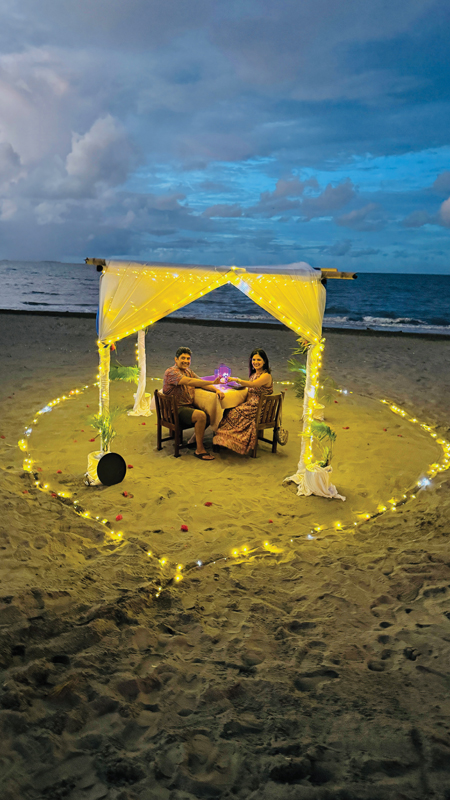 Once we landed in Nadi (pronounced Nandi), the major tourist hub in Fiji, the warm, humid air and lush green vegetation welcomed us to the tropics. As I looked out the taxi window on our way to the hotel, I saw endless coconut trees, sugarcane fields, and farmlands. Many businesses had signs suggesting Indian last names, and I could see small temples in the courtyards of the local homes. The scene reminded me of a small town in southern India.
Once we landed in Nadi (pronounced Nandi), the major tourist hub in Fiji, the warm, humid air and lush green vegetation welcomed us to the tropics. As I looked out the taxi window on our way to the hotel, I saw endless coconut trees, sugarcane fields, and farmlands. Many businesses had signs suggesting Indian last names, and I could see small temples in the courtyards of the local homes. The scene reminded me of a small town in southern India.
Fiji is a tiny country in the Pacific, consisting of 333 islands. From Auckland, New Zealand, and Sydney, Australia, it is only a three–to–four hour flight. From the U.S., the flight is about 10 hours long. Suva, the capital city, is mainly known for being a commercial hub. Tourism is the primary economy, and Fiji has become one of the world's top honeymoon destinations.
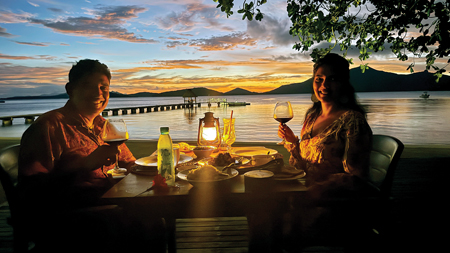

Fiji is consistently ranked as one of the top honeymoon destinations by the media in the travel industry. (Photos: Sucheta Rawal)
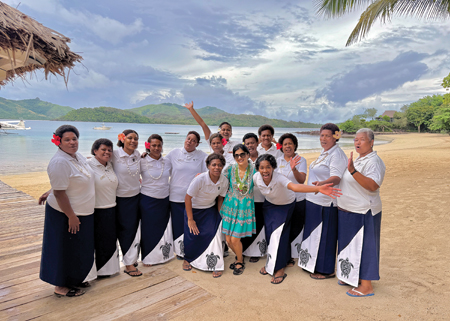
[Above & Below] A staff of over 80 people for just a dozen guests means the guests feel like celebrities. (Photo: Sucheta Rawal)
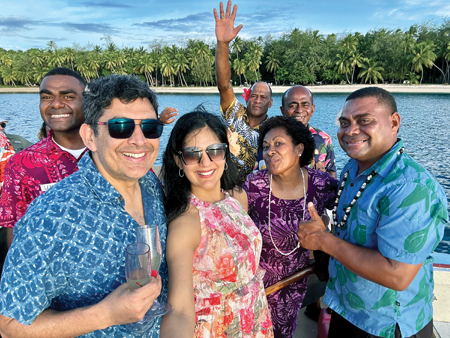
The number one honeymoon hotspot
Most tourists arrive in Nadi and connect to one of many island resorts via boat or seaplane, which is what we did. From a Turtle Airways Seaplane Base in Nadi, we flew 30 minutes north over crystal clear waters, vibrant corals, and lush island foliage. Our pilot, Peter, was accompanied by his newlywed wife, dressed in shorts and a t-shirt and adorned with gold bangles and a mangal sutra.
It was no coincidence that I chose Fiji as the getaway for my 25th wedding anniversary—our second honeymoon. The hospitality industry in Fiji prides itself on creating memorable moments for your special occasions. Over the course of a single dinner at the restaurants, it is not uncommon to hear the entire staff sing “Happy Birthday” or “Happy Anniversary” at least a dozen times.
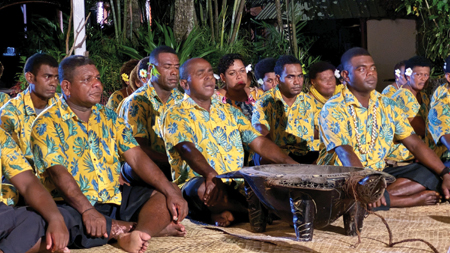
[Right] The hospitality industry in Fiji prides itself on creating memorable moments for your celebration of special occasions.(Photo: Sucheta Rawal)
Turtle Island is a private resort known to be crème de la crème when it comes to seclusion, romance, and service. High-profile celebrities such as John Travolta celebrated his 50th birthday here. Al Gore is a regular guest. Both Britney Spears and Jessica Simpson honeymooned at the resort. The Oprah Winfrey Show featured it as one of the world’s outstanding honeymoon destinations.
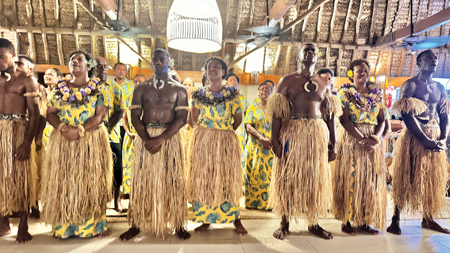
[Left] Performers at the resort sporting traditional garb. (Photo: Sucheta Rawal)
As one of a dozen guests on a 500-acre island, attended to by a staff of over 80 people, I did feel like a celebrity! Over the next week, they spoiled us with flower garlands, cakes, singing, and decorations on our bed. My traditional bure, a cabin made of wood and straw, was a spacious villa with a patio bed, living room, king-size bedroom, walk-in closet, hot tub, and indoor and outdoor showers.
A “bure mama” was appointed to attend to my every need. There were no phones or WiFi, so Mama Lou and I communicated via a walkie-talkie. She brought us breakfast as soon as we concluded our morning yoga and set up a small table for just the two of us at the beach in front of our thatched-roof bure. Under the shade of coconut trees, with a view of the ocean, we sipped on masala tea and nibbled on lobster omelets and Lolo Buns.
In the afternoon, each couple was escorted to a private beach from a choice of seven such beaches—where it was just us and a picnic basket containing champagne, fresh tropical fruits, and curry-roti. As we strolled on the gentle, secluded white sand beach and dipped in the warm waters, we were reminded of scenes from The Blue Lagoon, the famous 1980 movie starring 14-year-old Brooke Shields, filmed at this very same spot.
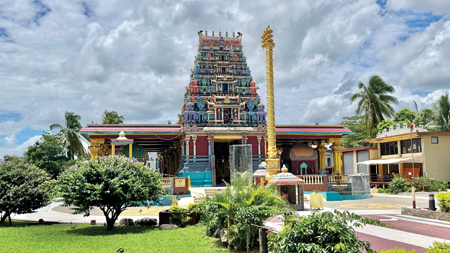
The Sri Siva Subrahamaniya Swami Mandir in Nadi is the largest Hindu temple in the Pacific. (Photo: Sucheta Rawal)
Each day had a similar relaxed pace, interspersed with activities of our choice. We opted for a magical sunset sail, snorkeling around the protected coral reef, and a horseback ride to the highest point on the island. In the afternoon, we joined the staff for beach volleyball and compared notes with other guests over sundowner cocktails. The skies surprised us each evening with hues of orange, pink, and purple.
The resort’s head chef, Beni, incorporated Fijian, Indian, and Western flavors. There was mud crab curry with coconut milk, kokoda (similar to ceviche), octopus in coconut cream, whole baked mackerel, and Fijian Lovo (marinated meat cooked in a pit with hot stones). The entrees were served with fresh salads, vegetable fried rice, and breadfruit chips. Eighty percent of Turtle Island’s food is grown on the island or caught by local fishermen, and it shows. The taste of freshness is evident on every plate.
Desi at heart
At my hotel in Nadi, I asked the concierge to arrange for a driver- cum-guide to take my husband and me around the city for a couple of days. She connected me to one named Jitender, and as we negotiated the details of our tour over the phone, we both realized we shared a common heritage. “Can we switch to speaking in Hindi?” he asked, and I responded with a delightful “Haan bilkul!” I instantly felt a connection to the place and the people—and little less of a tourist.
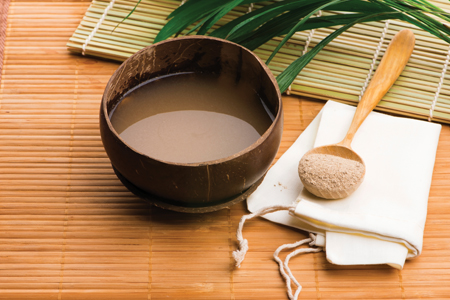
[Left] Kava, a popular herbal drink that is mildly narcotic and sedative, is served from large communal bowls called tanoa and poured into halved coconut shells.
The British brought Indians to their Colony of Fiji as indentured laborers between 1879 and 1916 to work on sugarcane plantations. At one point, Indo-Fijians made up 50 percent of the population. Today, they make up 37.5 percent of the population, and the nation has even had an Indo-Fijian Prime Minister, Mahendra Chaudhry. Despite the generations that have passed, they retain a strong sense of Indian identity, though many of them are unable to trace their ancestry.
When Indians first migrated to Fiji, they spoke their native Bhojpuri, Tamil, Punjabi, and many other languages. But over the years, Hindi emerged as the common language. Many locals converse fluently in Hindi. An ATM at a Bank of Baroda branch even had the option to proceed in Hindi. Signs like “Om” on storefronts made me feel that I was somewhere in India.
Indo-Fiji melting pot
My driver, Jitender, a lean guy in his 50s, told me that Indian culture is firmly embedded in the Indo- Fijian population. It is also “blended in, not watered down” with Melanesian Fijian culture. While Christianity is the leading faith among natives, 28 percent of the population is Hindu. As devout Hindus, they have built temples at home, they observe fasts, and abstain from meat on certain auspicious days of the week. There are weekly Satsang meetings where friends and neighbors gather to chant prayer songs, read Bhagwat Gita, and play dhol.
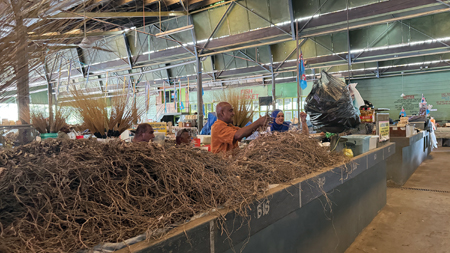
[Right] At the local markets, most of which are owned by Indo-Fijians, entire sections sell yaqona roots from which kava is made. (Photo: Sucheta Rawal)
At these gatherings, instead of chai, they drink kava, a popular herbal drink that is mildly narcotic and sedative. It is made by crushing the roots of yaqona and straining them with water. Most Fijians indulge in kava ceremonies whenever they get together (which can be daily). The drink is served from large communal bowls called tanoa and poured into halved coconut shells. At the local markets, most of which are owned by Indo- Fijians, there are entire sections selling yaqona roots.
In Nadi, we took off our shoes and walked on the steaming hot concrete to pay our respects at Sri Siva Subrahamaniya Swami Mandir, the largest Hindu temple in the Pacific. The colorful architecture is largely inspired by temples in Tamil Nadu. Devotees flock here on weekends and for annual puja ceremonies. Next door is Saravana Bhawan, a casual vegetarian canteen selling thalis, samosas, dosas, vada, and laddoos at very affordable prices.
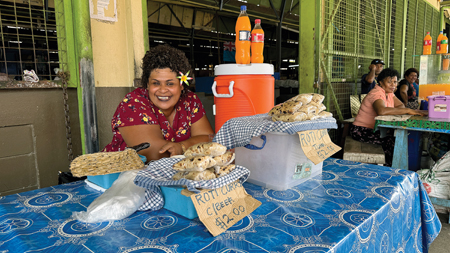
[Left] A vendor selling parcels of roti rolls stuffed with corned beef or tuna. (Photo: Sucheta Rawal)
In the city center, there are more Indian stores to fill half-a-dozen Global Malls. The largest retailer in the country, Jack’s of Fiji, was founded in 1969 by Jekishan “Jack” Khatri. It employs over 1200 people at its 50 stores, farms, manufacturing plants, and half-a-dozen restaurants across the island. You can hardly turn a corner in Fiji without recognizing the brand. At their store called “Little India,” rooms are filled with colorful beach shirts, kurta pajamas, saris, Indo-western gowns, jewelry, and Indian wedding ware. The streets are also dotted with dhabas and casual Indian fast-food restaurants offering pre-made curries, chop suey, and daal-bhaat. Mithai shops, bakeries, and street vendors sell parcels of roti rolls stuffed with corned beef or tuna.
Bula culture
I often heard my name spoken aloud as we walked around Turtle Island. “Bula Sucheta!” exclaimed the gardener, housekeeper, activities director, and the server each time I passed by. Bula, which literally means “life” and “good health,” is a way of saying “Hello” in Fiji, but it has much more enthusiasm than just “Hi.” In Fijian culture, it is polite to say “Bula” to everyone you meet, even if they’re strangers. But I never did feel like a stranger here. And there’s always an intention of getting beyond the hello and genuinely getting to know someone. Like I have experienced many times in India, people in Fiji will eagerly strike up a conversation and engage you with stories.
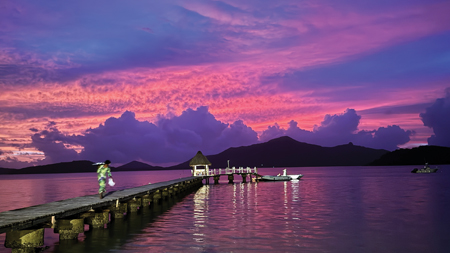
The skies surprised us each evening with hues of orange, pink, and purple. (Photo: Sucheta Rawal)
Dressed in sarongs and t-shirts, the entire staff and guests sat cross-legged on mats under the Baka tree as the stars fell upon us. We gathered for the nightly post-dinner kava ceremony. Once the drink was poured and everyone had accepted it with a ceremonious “Bula!” the lead guitarist, Nico, started the music. It took me a minute to catch the lyrics. In what sounded like a Bihari accent to me, he sang, “Yeh dosti nahi bhulenge” (“We won’t forget our friendship”) from Sholay, the epic Bollywood movie released in 1975. Everyone in the crowd seemed to know the lyrics, as they were familiar with old and new Bollywood songs. Turtle Island’s carpenter, Ashwin, and accountant, Abhi, and I continued our conversations in Hindi. Nico’s song ended with something like, “Haiya haiya... shaadi banao,” and we all laughed, sang, and shared this special bond, creating memories that will last forever.
Sucheta Rawal is an award-winning food and travel writer who has traveled to over 100 countries across seven continents, experiencing the world through her palate. She has been named one of the most influential cultural bloggers in the world for her blog Go Eat Give. Find her on social @SuchetaRawal.
Enjoyed reading Khabar magazine? Subscribe to Khabar and get a full digital copy of this Indian-American community magazine.
blog comments powered by Disqus











